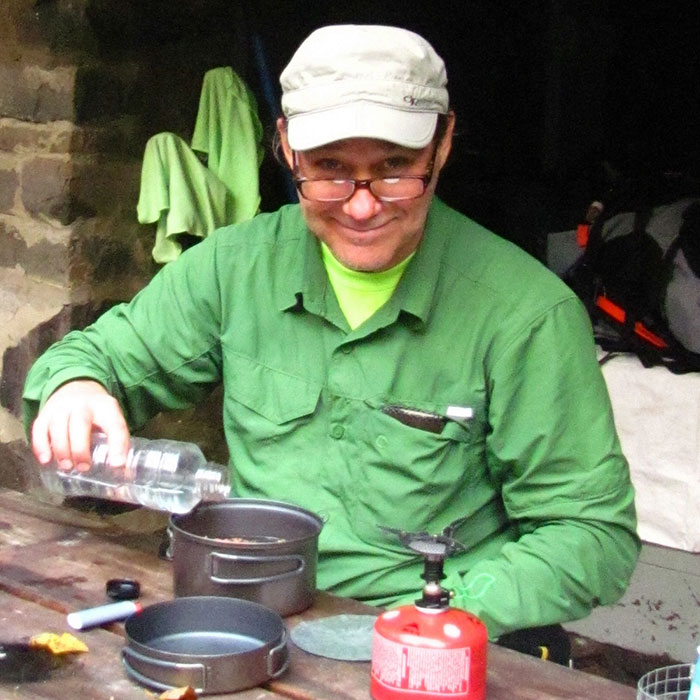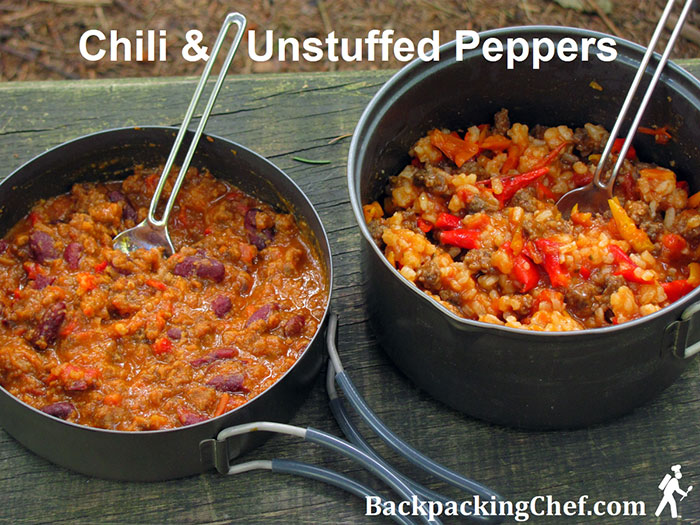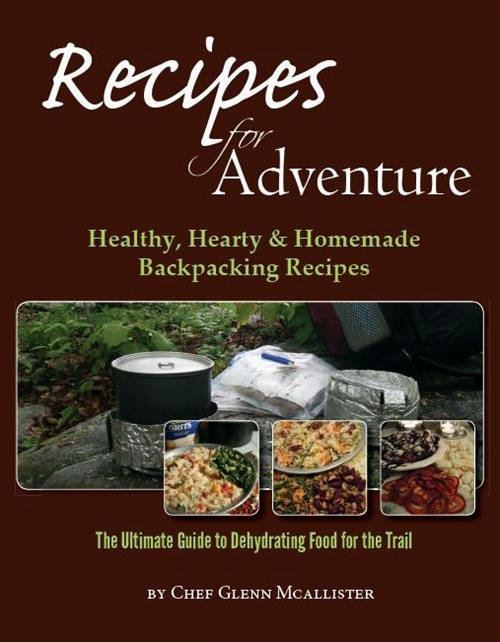
People write to me from all over the world — and I write back. It’s nice having those exchanges. One person sent a note from Switzerland. A year later, we got married.Glenn from backpackingchef.com
Finding his future wife was not on Glenn’s agenda when he decided to start his online business, BackPackingChef. He wanted to build a profitable, long-term business that would help him pay back the $89,000 in debt he had inherited from a previous start-up attempt.
He also wanted to be his own boss again, while doing something he loved. And — as the old saying goes — when you follow your passion, good things will happen.
You think that’s only true in fairy tales? Glenn’s story says otherwise. Let’s “hike” in…
1. Glenn, how did you decide about your niche, backpacking food? How did you know it was the right topic for you and had great business potential?
I wanted a business related to what I loved doing — hiking. I was just getting into backpacking when I started the website, so I plugged “backpacking” into SBI!’s Brainstormer keyword analysis tool. There were lots of good keywords, mainly about backpacking gear.
I didn’t really want to spend my time reviewing gear, so I drilled down to a smaller, but attractive niche about backpacking food, recipes, meals, etc. They all looked very “winnable” with decent demand and low supply.
Since backpacking food needs to be light-weight and keep well, I also brainstormed keywords about dehydrating food. My site became a combination of two keyword concepts — backpacking and dehydrating food — that I spun into the topic of “how to dehydrate your own backpacking food.”
This required a great deal of experimenting with food and developing recipes — which turned into my new passion.

First, you need to know your broad area of interest. What’s your passion, hobby, or special skills? Glenn loves hiking and backpacking. So he used “backpacking” as the so-called “seed word” for Brainstorm It!, SBI!’s smart keyword research and analysis tool.
Brainstorm It! brings back hundreds of keywords (aka “topics”) related to your niche concept. For each keyword, it tells you how many people search for it (demand) and how much competition there is (real supply).
You’ll then evaluate the keywords brought back by Brainstorm It!. With the help of the detailed explanations and step-by-step process in the SBI! Action Guide, you’ll answer questions like:
Is my niche too broad? Is it too narrow? Is there another direction I could take? How profitable is my niche?
You may even combine two topics and spin it into one “Goldilocks niche,” just as Glenn did by combining backpacking and dehydrating food.
2. Tell us about your philosophy regarding content. How do you know what your prospective customers are looking for? Where does this information come from?
Ken Evoy (the founder of SiteSell) knows content: “Over deliver.” I took his advice as gospel and still do.
Readers want detailed instructions with step-by-step photos. I don’t waste their time with excessive folksy talk, although my personality does come through.
I have a contact form on my site. People send me thank you notes, so I know I’m on the right track with content.
They also ask questions, and that helps me address topics that they want to learn about. In addition, I send out content-rich newsletters to engage with my fellow adventurers.
Glenn mentioned three crucial factors:
1) You OVERdeliver. Whether it’s the content on your website, in your newsletter or on your social media accounts, you strive to be a few cuts above your competitors. You present your visitors with the best, well researched and well written content tailored to their question or need. Add good visuals to the mix, and you truly make your content spark! ⚡
2) You develop a “Brand of One.” In the all-important preparation phase for your online business, you’ll create a thumbnail or persona of your ideal visitor / customer. The more you know your niche, the easier this will be. If you’re unsure, the Action Guide shows you techniques about how to research your target audience online.
At the end, you’ll have a clear picture of your future customer in mind. This determines how you “talk” with him or her. You’ll develop your unique “voice” which is part of your “Brand of One.” As Glenn said above, he knows the language that resonates with his audience (no excessive “folksy talk,” but still with his personality shining through).
3) You build a relationship with your visitors. You invite visitors to interact with you, both on your website (contact form, newsletter opt-in, commenting feature) and through social media. You must of course hold up your end of the conversation by swiftly replying to questions, acknowledging comments and sending out regular newsletters with high-value information.
All of the above is part of SBI!’s C T P M approach. More on this after the next question.

3. You provide lots of information and resources for free. How do you “upgrade” people from being free content seekers to paying customers?
All that information was and is necessary to achieve and maintain high search engine rankings for my keywords. The visitors find a great resource which they come back to and share with friends. Bloggers in related niches link in.
My site has lots of photos, so Pinterest is a big referrer. The vast majority of visitors just go with the free information on the site.
But there are enough people who do buy the book. They like having all the content nicely formatted in a cookbook which they can use in their kitchens. On my sales page, I tell customers what extras are exclusively in the book.
First, he provides the Content that hikers and backpackers are looking for. His high-quality topical content gets found (search) or discovered (social), attracting free targeted Traffic (aka interested visitors).
Once on the page, his visitors are hooked because Glenn OVERdelivers… he presents the best possible answer to what his visitors are looking for, in a unique “been there, done that” voice. Now, some of those visitors may just read an article or two and leave. Others will want to know more and subscribe to Glenn’s newsletter (which means he can reach them again, with more chances to promote his products).
And enough of his PREsold visitors are happy to buy his books, which is one of the ways Glenn Monetizes his online business! How else does he monetize? He answers that question next.
4. How many different revenue streams do you have? Which ones perform best?
I currently have two revenue streams. My prime revenue stream is the cookbook and a companion workbook. I just published a second book about hiking the Appalachian Trail, so we’ll see how that turns out.
My second income stream is a few select affiliates. Amazon generates the most money. When people go there and purchase a product that I recommend, they often buy all kinds of other stuff. Once I earned a $100 commission on a dog kennel.
All my affiliate links are text links in line with the content. I make it clear that the visitor will go to the recommended site to view the product. A few of the products are high-end appliances that generate nice commissions.
I had AdSense at the beginning, but dropped it because ads were often irrelevant, and I didn’t want to send visitors away for a few pennies.

But in recent years more and more website owners turned away from AdSense, because revenue continued to drop. So why would they risk to lose their visitors for a few pennies and possibly annoy them with irrelevant ads?
Some SBI! members have successfully replaced their AdSense income by promoting more and better paying affiliate products. If you’d like to learn more about how to do this, check out Jill’s story.
What’s even better than promoting other people’s products? Creating and selling your own! Selling your own products (or services) may sound daunting to you, but as an SBI! member you don’t have to figure this out on your own. You’ll have access to video, audio and written tutorials in the Action Guide, a comprehensive collection of articles, like-minded solopreneurs in the Solo Build It! forums and SBI!’s world class customer support team.
5. You’ve published several books, in digital and print format. Can you share your top 3 tips about creating and selling books for people who may be considering this as a way of monetizing?
Tip #1: Hire professionals if you need help with grammar or layout.
I published my cookbook initially as a PDF using MS WORD to format the pages. I just barely managed considering my skill level. With the revenue earned from the initial PDF sales, I paid a book formatting specialist to lay out the book and design the cover for print.
For my next book, I paid an editor and a book formatting specialist; I launched it in three formats simultaneously: paperback, Kindle, and PDF. Freelance book editors and book designers are easy to find online, and you can check their references and rates.
Tip #2: Publish paperback books with CreateSpace and PDFs with E-junkie.
CreateSpace’s digital print-on-demand platform, with sales through Amazon, eliminates the risk of carrying inventory, and the whole fulfillment process goes on automatically. You can also upload your book to Kindle through CreateSpace.
After launching the printed cookbook, I still sell just as many PDFs as before, especially to customers in Canada and Australia. E-junkie processes all my PDF sales.
Tip #3: Offer a valuable add-on item.
After I published the cookbook, I began offering a workbook to go along with it. I priced it at $7.95, but if purchased with the cookbook, the cost was only $2.95. More than half of the customers take the deal, increasing my revenue.

6. Glenn, you paid off $89,000 in debt and retired from your nine-to-five job, all thanks to your online business. What do you see as the top contributing factors to this remarkable success?
The first step was to stop the debt. Before I found SBI!, I had quit my day job and started a business with high inventory and start-up costs, all financed with credit cards. Accepting failure after a year of struggling, I went back to work for the same company I had left.
A non-profit debt consolidation organization negotiated lower interest rates. They also distributed one monthly payment to eight credit card companies. I paid back over $89,000 in six years. Never again.
I worked on my SBI! business in my spare time, and income came in gradually. At first it covered the annual cost of the SBI! subscription. Then it paid for all my food expenses. That gave me a nice feeling of security.
Next it covered the debt payments, too. My day job paid for everything else. A year after the debt was paid off, with income from my SBI! business exceeding what I was making with my day job, I went solo.
When you repeat a mistake, it’s not a mistake anymore. It is a decision.Paulo Coelho
Glenn clearly did not repeat his mistake. Instead, he applied what he had learned from his failure. In his second attempt, he chose a business model with low startup costs (an online business) and began building it in his spare time, while continuing his day job.
That’s the beauty of an online business. There’s no expensive inventory to buy, no premises to rent, no equipment to purchase. All you need is an idea and the willingness to work consistently towards your success – whether that’s 8 hours per day or 8 hours per week. You determine the pace.
A word of caution though: just because it costs less to start a business online than offline, it does not mean you should treat it anything less than as proper business. You are not simply “putting up a website that makes money.”
Having a business mindset from day zero (from the moment you decide to start your solopreneur journey) is the key that sets you apart. It may sound small to you, but it impacts in important ways, from how you prioritize your limited time to planning a monetization mix that maximizes your income.
A business mindset keeps you on track. Shift your focus from “putting up a website” to building a long-term business with ever-growing profits and equity.
7. What has been your biggest challenge so far as a solopreneur?
I have some bad days when I want to write and not much comes out — call it brain fog. The saving grace is that the work that’s already done stays in place. The business continues to function on auto-pilot in the background.

Or, if you are determined to write this piece right now, try this cool tool to beat writer’s block. Careful though – it’s called the “most dangerous writing app” for a reason.
Glenn touched upon another big benefit of having an online business. Once you have a solid foundation, it works on “auto-pilot” — but only if you’ve built it the right way.
What is the right way? For most niches, we recommend a “theme based content site” with evergreen content rather than the classic blogging.
To learn more about the advantages of a theme based content site over blogging, check out this article.
So, whenever you feel frustrated that your new article took you ten hours instead of two, remember that it will continue to attract targeted visitors for years to come. The autopilot function of an online business can even sustain you financially during years of illness as the case study of long-term SBI! member Birgit Bradtke shows.
8. What do you enjoy most about being an online business owner? How has it changed you, your family, and your life?
People write to me from all over the world — and I write back. It’s nice having those exchanges. One person sent a note from Switzerland. A year later, we got married.
With no ties to a bricks and mortar business in the USA, we live mostly in Switzerland. The work I do as a solopreneur doesn’t really feel like work. I get to be creative and have fun — in a structured, purposeful way that helps others.

One person sent a note from Switzerland. A year later, we got married.
That short sentence from Glenn made us sit up… he met his wife through his online business. Wow! That’s a first among the many solopreneurs we interviewed. We were of course curious how exactly this happened. So we asked Glenn if he’d share a bit more with us. Here’s what he said:
“It was one of those ‘connect the dots’ sequence of events that lead to our meeting. The note that I received from Dominique came through Facebook. A different woman, whom I had met on my first month-long hike on the Appalachian Trail (in the fog on top of Bald Mountain), sent me a note on my contact form that she posted the photo she took of me on her Facebook page.
So, curious, I signed up for Facebook. A few months after that, Dominique found me by accident when she was looking for relatives in America. It turned out that she had the same last name as some old friends of mine from high school.
I gave you the simple explanation in the interview question, since it’s a long story, but feel free to mention it. It is also in the introduction of my new book which is on my website. Scroll down to the bottom of that page to read the full story.
Have a great week. I’m heading back to the states on Saturday for a couple of months. Dominique comes later in the middle of the trip. That’s the way we work it with homes in two countries. Thanks SBI!”
![]()
You may start a new professional career that you had never thought of pursuing (Crystal’s story is a great example). You may be approached about writing a book for a renowned publishing house. You will most definitely “meet” people from all over the world through your online business. And you may even find the love of your life.

9. And finally… What’s your top tip for someone who is just starting a solopreneur career?
Write for your niche, not about your niche. Offer specific solutions that will improve the lives of the people you attract to your site.
It’s interesting how Glenn puts it when he advises to write for your niche, not about it. In other words, put the interests of your visitors first. Write to please your human visitors, not the search engines. Listen to their needs, their “gain and pain” points and dreams, then solve those with your content. Your visitors will like and trust you. And, as we all know…
People prefer to do business with those whom they like and trust. Then, and only then, will they happily pay for your services or products.

Latest posts by Margit Streifeneder (see all)
- From Traffic Peaks to Auto-Pilot: A Psychologist’s Website Success Story - March 27, 2025
- From Swim Teacher to Solopreneur: Building Passive Income Online - February 27, 2025
- From Concierge to Global Tours: 10 Lessons for Travel Business Growth - December 19, 2024

